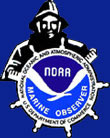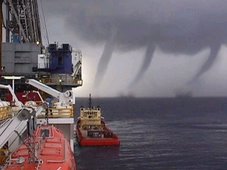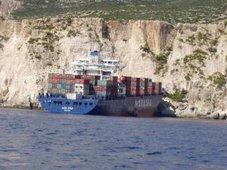 Navy's phased array radar being adapted for weather use
Navy's phased array radar being adapted for weather use A National Weather Radar Testbed has been established at the National Oceanic and Atmospheric Administration's National Severe Storms Laboratory to provide the meteorological research community with the first surveillance phased array radar facility available on a full-time basis.
Norman is already known as a national center for weather radar research and development. NSSL's research in Doppler radar led to one of the most successful and significant technology advancements since the launching of the first weather satellite.
Nearly 30 years ago, NSSL was a major participant in the development of Doppler technology that became the heart of the WSR-88D radar, or NEXRAD.
The deployment of a system of 120 NEXRAD radars across the United States was the cornerstone of the modernization of the National Weather Service.
Installation of the SPY-1A antenna and radome on the NWRT

Phased array radar is currently used on Navy ships to support tactical operations.
Phased array radar technology may help forecasters of the future provide earlier warnings for tornadoes and other types of severe and hazardous weather. Researchers are adapting the SPY-1 radar technology, developed by Lockheed Martin to support tactical operations aboard Navy ships, to weather detection. The phased array radar project has begun a new stage in NSSL's leadership in the research and development of future generations of weather radar.
Research Partnerships
A unique federal, private, state and academic partnership is developing the phased array radar technology. Participants include NOAA's National Severe Storms Laboratory and National Weather Service Radar Operations Center, Lockheed Martin, U.S. Navy, University of Oklahoma's School of Meteorology and School of Electrical and Computer Engineering, Oklahoma State Regents for Higher Education, the Federal Aviation Administration, and Basic Commerce and Industries. The project - from research and development to technology transfer and deployment throughout the U.S. - is expected to take 10 to 15 years at an initial cost of approximately $25 million for the facility in Norman.
Promising New Radar Technology
Early tests of the phased array radar system show that the technology has the potential to vastly improve upon the capabilities of the national NEXRAD radar network for all weather radar applications. Using multiple beams and frequencies, phased array radar reduces the scan time of weather from five or six minutes for NEXRAD radar to less than one minute, producing fast updates of weather data.
The National Weather Radar Testbed allows NSSL and other meteorologists to determine if phased array radar will become the next significant technology advancement to improve our nation's weather services.
![]()
The rapid scanning ability of phased array radar gives it the potential to be a multi-use, adaptively scanning radar.
Improved Warning Lead Time
In addition to faster updates, the new system can scan the atmosphere with more detail at lower elevations than current radar allows. It can also re-scan areas of severe weather very quickly, potentially increasing forecasters' warning lead times as storms rapidly transition to severe modes.
PAYOFF: This technology has the potential to increase the average lead time for tornado warnings well beyond the current average of 11 minutes. Other technology being developed at NSSL will extend lead times even farther.
Improved Understanding and Forecasts
The new technology will gather storm information not currently available, such as rapid changes in wind fields, to provide more thorough understanding of storm evolution. Researchers and forecasters can then improve conceptual storm models and use that knowledge to evaluate and improve stormscale computer models. The data will also be used to initialize computer models and improve forecasts.
PAYOFF: Phased array technology will increase fundamental understanding of storm evolution, in turn leading to improved computer models, more accurate forecasts and earlier warnings.


Reflectivity and velocity displays of the first tornadic storm captured with the NWRT
WSR-88D Improvements
- Faster and better signal processing will extend the usefulness of the current National Weather Service radar network.
- Adding dual-polarization capability to the WSR-88D radar network will improve precipitation discrimination and estimation and improve hazardous weather detection, extending the functionality of the current NEXRAD system.
- Implementing range and velocity ambiguity mitigation techniques in the WSR-88D radar network will result in an improved ability for the WSR-88D to detect severe weather, flash floods, winter storms, and provide aviation forecasts.
- An increased ability to identify aviation weather hazards and to track, classify and identify aircraft will improve airline safety and help fill gaps in homeland security.
- Phased array technology could significantly extend warning lead times, increase accuracy, and reduce the uncertainty of predicting severe weather events.
- Adapting phased array technology to both weather observation and aircraft surveillance will provide significant cost benefits and a higher level of security to the nation
- Researching and prototyping new severe weather warning applications using WDSS-II multi-sensor technology will help fast-track improvements into operations and provide a robust decision support system for forecasters.
- The National Weather Radar Testbed at NSSL will shorten the cycle time from weather radar research to National Weather Service operations, leading to increased accuracy and lead-times, and reducing the uncertainty of predicting severe weather events.
- A cost-effective network of many small radars that can scan lower regions of the atmosphere will provide better weather coverage in high population or weather-sensitive areas.
- Mobile radars can operate in the near-storm environment to provide scientists with data that corroborates their research.
National Severe Storms Laboratory Chief of Radar Research and Development Doug Forsyth discusses aspects of radar research and what’s in store for the next generation of weather radar. Recorded 8 November 2007
- Section 1 - Types of radar research done at NSSL (5:43)
- Section 2 - Transition of research to operations for new radar applications (3:11)
- Section 3 - Doppler radar and new radar technologies being researched and how they compare (8:39)
- Section 4 - Advantages of collaborative radar research (3:24)
- Section 5 - Doug discusses his career and his advice for people considering a career in the atmospheric sciences (6:09)
![]() LISTEN TO THE COMPLETE PODCAST RUNTIME 27:08 TEXT TRANSCRIPT
LISTEN TO THE COMPLETE PODCAST RUNTIME 27:08 TEXT TRANSCRIPT
BE READY CAMPAIGN
Tennessee Severe Weather Awareness Week: Feb. 24-29
The National Weather Service, the Tennessee Emergency Management Agency and other supporting organizations are working together to help in providing the public with information about severe weather safety. Advance planning and increased awareness will help Tennesseans survive these deadly storms. Governor Phil Bredesen has proclaimed February 24-29, 2008, as "Severe Weather Awareness Week" in Tennessee.As we move into our Spring, now is the time to prepare ourselves for the hazards and dangers associated with severe weather. Severe weather can and does occur any time of the day and anytime during the year. Are you prepared?
Click on the link to download the booklet. Severe Weather Awareness Week Booklet 2008
MS Severe Weather Awareness WeekEmergency Management Looking for Severe Weather Spotters
Towson, Md. (February 7, 2008) – Local weather buffs have an opportunity to put their interest in meteorology to valuable practical use.
The Baltimore County Office of Homeland Security and Emergency Management is recruiting volunteers to help spot severe weather. The volunteers would be part of SKYWARN, a national network of amateur severe weather spotters, trained by the National Weather Service to spot severe thunderstorms, tornadoes, hail and flooding, snowfall and ice accumulation.
Along with the National Weather Service, the Office of Emergency Management will sponsor a SKYWARN and Spotter Class on Tuesday, March 11, 2008, 7 to 10 p.m., at the Baltimore County Public Safety Building, 700 E. Joppa Rd., Towson. The class will be held in the 6th floor conference room.
The class is free of charge
To register, email tbrush@baltimorecountymd.gov, or call the Office of Homeland Security and Emergency Management at 410-887-5996.
INTERNATIONAL WEATHER
By Arthur Rabjohn CEM
ENGLAND: Council flood funding payments exceed £15million Floods Recovery Minister John Healey today announced over £2.5million funding for six authorities across the country, to help them get back on their feet following last summer's floods. This means that over £15million has now been paid out under the Bellwin scheme, which covers costs incurred by local authorities during immediate action to safeguard residents and property or prevent suffering as a result of a disaster or emergency. This money is on top of up to £63million of other Government support made available to help flood-hit communities. FULL ITEM AT: http://www.communities.gov.uk
USA: Night of Texas Wild Fires followed by fog chaos. Closure of Houston Hobby Airport led to major disruption as a result of dense fog. Planes were diverted to other airports, mainly DFW, and passengers sat on the tarmac for over two hours in some cases. Following a night of wildfires was there a connection?
NAMIBIA: Emergency Management Gets Blasting Omusati Governor Sackey Kayone has criticised the Regional Emergency Management Unit (REMU) for lack of means to respond to emergency situations. In a speech delivered on his behalf by Outapi Councillor Simon Shileka, he expressed reservations with the way finance is centralized at the expense of regional emergency units. MORE AT: http://allafrica.com/stories
INDONESIA: A powerful earthquake hit off the coast of Indonesia's Sumatra island. The quake was centered about 160km south-southwest of Padang and had a magnitude of 7.3, and occurred at about 10km beneath the seabed. There are no reports of casualties or damage. A local tsunami watch has been issued and lifted after.
CHINA: China has forecast heavy snow and blizzards across its industrial and agricultural heartland over the next three days. At least 129 people have died. Transport is in chaos and cut off power and water appeared. Severe weather damaged millions of hectares of crops and killed more than 70 million animals. Snow and sleet would hit six provinces spanning China's central, eastern and northern regions. Blizzards were also expected in the northwestern part of central Hubei province, already plagued by winter storms earlier this month.
MADAGASCAR: Nearly 145,000 people have been left homeless by a cyclone that tore through Madagascar, killing 44 people. Cyclone Ivan struck the island's east coast last Sunday, and was followed by torrential rains which caused flooding. Winds gusting at more than 230km/h caused widespread damage. Infectious diseases such as diarrhoea are reported to be on the rise. The cyclone season is not expected to end until April, so the government has warned that further storms could follow.
ECUADOR: Persistent rains and floods have left Ecuador in a state of disaster as concern aver food shortages grows. Rains and swollen rivers have caused flooding in 13 of the country's 24 provinces, destroying homes, crops and infrastructure. At least 300,000 people have been affected, including 20,000 evacuated. 110,000 hectares of crops, including rice, coffee, corn, banana, cacao and sugar cane have been destroyed. A national emergency has been declared. EU MIC is monitoring the situation.
MARITIME NOTES:
By Nadim Kawach on Sunday, February 24 , 2008

Shipping accidents have increased sharply worldwide over the past few years because of the introduction of complex systems and a lack of experienced crew abroad vessels, according to a specialised organisation.
The surge in accidents has boosted business at shipping yards and consequently pushed up the cost of vessel repair and maintenance, the Singapore-based DNV company said in a report sent to Emirates Business.
“Updated figures for 2007 show that the losses from navigational accidents within the shipping industry are continuing to increase. This trend was also confirmed by the insurance industry. Premiums may increase by as much as 30 per cent in 2008,” DNV said in the report, presented at a shipping conference yesterday.
“DNV monitors the frequency of serious accidents. Over the past five years, there has been an increasing incidence of serious navigational accidents in several shipping segments. This increase is confirmed by many insurance companies such as Skuld, Norwegian Hull Club and The Swedish Club,” said DNV, which covers a wide range of services including classification, certification, consulting, training, asset operations, verification, laboratory testing and technology qualification.
In addition to the increasing frequency of navigational accidents, the cost of each repair caused is rising.
The yards are overbooked, making it hard to find a repair slot, resulting in increased prices for firms. Collisions, groundings and contacts now account for 60 per cent of the most expensive accidents.
The report quoted Torkel Soma, principal safety consultant at DNV Maritime, as saying: “DNV’s statistics show a ship is twice as likely to be involved in a serious grounding, collision or contact accident today compared to only five years ago. In addition, estimates show the cost of these accidents has doubled. Since this is the general trend for the international commercial fleet, the maritime industry needs to act on this immediately.”
According to the report, the boom in the shipping market and increased deliveries of new ships have resulted in pressure on crews.
It says the shortage of officers has resulted in lower retention and faster promotion, adding that as a result, the general level of experience is decreasing on board. At the same time new technical solutions have also been introduced, which might have increased the complexity of operations.
“Reliable technology and complying manuals are no assurance against making errors. Collisions, groundings and contact accidents do almost always involve human acts,” Soma says.
Helge Kjeøy, regional manager DNV Maritime South East Asia, said: “The main factor explaining the negative developments over the past few years is the undersupply of crew worldwide. This results in reduced experience and the high commercial pressure results in high workload. Adding new and more complex equipment does not only help the situation. Avoiding accidents under such situations requires a good safety culture, something which the maritime industry evidently needs to focus more on.”
The experience of leading shipping companies shows the focus has to be turned more in the direction of human elements and organisational factors, including all those involved – from the directors of the company to the officers on the bridge.
Soma adds: “Safety improvements with reduced accident frequency have been achieved through a structured approach addressing behaviour and culture. For the industry to maintain its traditionally good track record, the resilience of operations has to be addressed on a larger scale.”
THE DNV REPORT
Singapore: Updated figures for 2007 show that the losses from navigational accident within the shipping industry are continuing to increase.
RS


































































































![Validate my RSS feed [Valid RSS]](valid-rss.png)